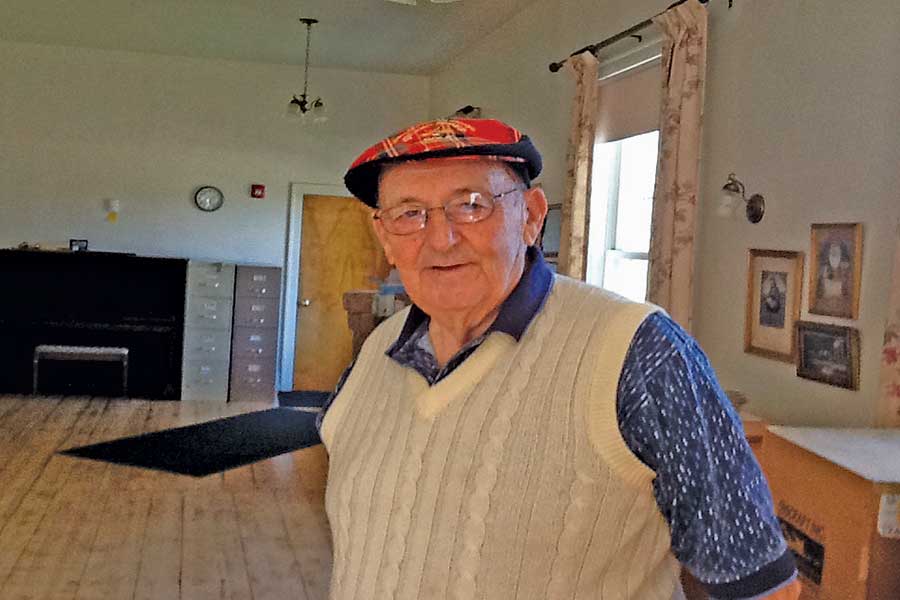Looking back 40 years: community effort evolves into local phenomenon
Dave Kelley
September of this year marked the 40th anniversary of the United Church of Underhill’s Old Fashion Harvest Market, and what started as a way to bring the community closer together has grown into a local phenomenon.
In 1975 the United Church of Underhill, located at the intersection of Route 15 and Park Street, in Underhill, Vermont came up with the idea of having an autumn community event. What has come to be known as the “Old-Fashion Harvest Market” did not start out with this now classic name.
Originally the event’s founders wanted to call it the “Fall Foliage Festival.” Little did they know that a couple of towns away in Johnson, Vt., community organizers there had already claimed that name for their own event. Not only was the name the same, but both events were scheduled to be held during the second weekend of October.
Not wanting to infringe on what Johnson had planned, the group did a little brain storming and came up with simply “The Harvest Market,” but that name did not last long either as there was a store located in Stowe, VT. called The Harvest Market.
So for a third time they went back to the drawing board in search of what to call their event. Eventually they decided on “Old Fashion Harvest Market.” This name was not being used by any other local organization and it best described the theme they were going for. “Harvest” described the time of year that the event is held, while “Market” lets people know that things will be for sale, and “Old Fashion” described the items and event you will find once you get there.
“We planned it for the second weekend in October,” said local resident Dave Kelley, remembering the weather on that first weekend. “It rained, it hailed, it sleeted and it snowed.”
When planning the event for the following year, everyone involved agreed that it should be held earlier. So they backed it up by exactly one week. But the weather on the first weekend of October did not prove to be much better. In fact, it was worse. “The third year we moved it to the last full weekend of September, and we had nice warm sunny weather, both days,” Kelley said.
The Old Fashioned Harvest Market started with a food tent and Crocker’s Clutter, a flea market run by the Church and named after the Church’s reverend at the time, Reverend Crocker. The food tent was nothing more than a large piece of canvas supported by some pipes with the ends of the tarp staked to the ground.
Crocker’s Clutter was held in the garage of the parsonage, as it was the only building available that was large enough to fit tables, the items for sale and shoppers. For the next couple of years the church borrowed tents from the Air National Guard before investing in tents of their own for the fifth annual Market.
For the initial event, church members were unsure what size crowd they would attract, and that made it difficult to predict how much food would be needed. They decided on hamburgers and hotdogs, 500 of each.
A member of the Women’s fellowship told them they would never sell so much food. Within the first three hours the food tent had sold out of both. In order to be able to open the food tent the following day, workers went to the local grocery store and purchased as much hamburger and as many hotdogs as they could find. Food sales the second day were on par with those of the first.
Entertainment has always been a big part of this Fall event. Games for children have included the ring or ball toss, a penny pitch, bobbing for apples, sack and three legged races, and tug of war. One year there was even a greased pole. The first child to the top would be able to claim the $20 bill that was tacked to the top. Much to the surprise of the crowd, one determined young boy was able to make it to the top and claim that $20, and it only took him three hours.
Seeing that entertainment is an important part of this festive time it is only fitting to have a live band perform. Mr. Ed’s Band or some variation thereof has played at every Old Fashion Harvest Market to date. They started on the parsonage front porch but have moved to the front of the church unless the weather does not cooperate, and then you can find them in the church sanctuary. As the Market has grown, more and more performers have been added to the venue.
As the years passed, the size of the Market grew. The food tent, now called the Country Store, started selling French fries in the fourth of fifth year. The church started with a single fryer that held 8-10 servings. The line for French fries was over 100 deep and the pint-sized cooker was not able to keep up with demand.
The next year they added a second fryer, and then a third and finally a fourth. Today french fries are one of the biggest sellers during the Market and operates out of its own concession stand. Last year alone the Market sold over 2,000 pounds of French fries. They also added many other items including cotton candy, pizza, corn on the cob, baked beans and penny candy, as well as baked products such as pies, cakes and breads. How much does food play a part at the Market? Last year the church sold 957 pies and 500 pounds of chili.
The size of Crocker’s Clutter has expanded past the capacity of the garage where it started. Fortunately for the Church, the Gifford Building, located on the property to the left of the Church came up for sale. So the United Church of Underhill purchased the Gifford building and moved Crocker’s Clutter to a more suitable location.
After awhile the name was changed to the Clutter Barn. Everything from coffee mugs, books, electronics, glassware, original paintings, and other collectables can be found inside, and of course there are toys, toys and more toys. The items in the Clutter Barn all come as donations to the church. Kelley estimates that it takes close to 500 hours researching and pricing all of the items.
Before the rise of the internet, items were researched using books or by taking it to an antique dealer or appraiser. Some items are still taken to an appraiser, but most of the research is done online. After getting a retail price for an item, Kelley cuts the price he finds by at least half, and often by much more. “It’s not about money, it’s about helping families” Kelley said.
Directly behind the Church there’s a flea market with almost 100 vendors and row upon row of goods. For the past several years the vendor space at the flea market has been sold out, and this year was no different.
In 1984 the Soup Bowl was added. The Soup Bowl is a community driven pot-luck featuring just what you would expect, soup. Since its inception the Soup Bowl sells out of soup on both days the Market is held. To go along with the soup they also offer cheese and crackers.
In 1994 the Soup Bowl published its first cookbook. The cookbook featured the recipes of all the soups that had been donated to the Soup Bowl throughout the years. They continued for three printings before quietly fading away. Then in 2001 requests started to come in for another cookbook. This time the Soup Bowl not only included soup recipes but they added casseroles as well.
Outside the church you will find a old fashion cider press that will be busy producing pure Macintosh apple cider. There have been some modifications to the cider press over the years like adding a motor to speed up production but at the heart of it all is the same press that has been used for nearly every Old Fashioned Harvest Market for the last four decades. The cider is available by the cup, served either hot or cold, or by the half or full gallon for those that would like to take some home. With the exception of a couple of years, all the apples come from Sunrise Orchard located in Cornwall. Currently they process an estimated 350 bushels of apples in just two days. Some years the cider is sweeter and some years it’s tart. When using only one type of apple you get what mother nature gives you. As the cider business grew they started offering cider doughnuts. Selling 50 dozen the first year, and last year they sold 450 dozen. That’s 5,400 doughnuts. When all the cider has been made, the doughnuts have been eaten, and the crowd has gone, the scraps are loaded up and donated to a local pig farmer.
Inside the church there were handmade crafts. Both upstairs and down are home to some expertly produced goods. The Cookie Factory was occupying the church kitchen; baking and sells thousands of cookies over the course of the weekend.
This year an estimated 20,000 people visited the Old Fashioned Harvest Market. Traffic on Route 15 slowed to a snails pace and there was a severe shortage of parking. “We have a parking problem, but we can’t avoid that,” Kelley said.
The 2014 Old Fashioned Harvest Market started like all those before it, with a 5k run/walk, followed by a parade led by Hanaford’s Volunteer Fife and Drum Corps. The Fire Departments from Jericho and Underhill were there, as well as many other organizations including the Boy Scouts, Girl Scouts and various musical acts. Those that made up the crowd lining the street received sweet treats, as hard candies were tossed from the trucks to the spectators.
As the festivities came to an end, and the crowd headed home, Kelley and the other volunteers that make up the workforce behind the Old Fashioned Harvest Market broke camp, scrubbed a mountain of pots and pans, policed the area for litter, plus many other behind the scene chores, and of course attention was paid to the Clutter Barn. All the time remembering good times past, and looking ahead to next years Old Fashioned Harvest Market.
Jeffrey joined the Basement Medicine staff in the Spring 2015 semester serving as staff writer and photo editor.






